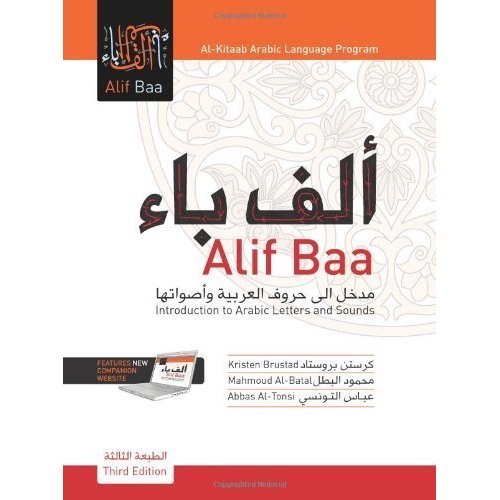One thing that I have noticed over the years has been that I have rarely encountered good Arabic textbooks for beginners. The majority of introductory Arabic textbooks either don't bother teaching the learner Arabic script at all (a huge disservice), or they expect students to be able to learn the script given only examples of calligraphic-style printing (problematic because this can vary greatly from handwriting). That is why I was very excited when I first picked up Alif Baa, one of the few textbooks I have seen that shows students how to properly write Arabic both in handwriting and printing. This may not seem like that big of a deal to teachers or those who have not studied Arabic before, but I think things like this can really make a great difference in the experience of students tackling the challenge of Arabic for the first time. Today I will be writing about Alif Baa, a book which I think is one of the most invaluable tools for the beginning Arabic student.
It is important to note that this book is somewhat of an atypical language text, as its primary focus is on teaching the sounds and script of the Arabic language. There is definitely an increased attention towards teaching conversation in the third edition, but instructors and students alike should be aware that this book does not drill grammar and vocabulary to the extent of your average textbook.
With that disclaimer out of the way, let's take a look at the content of this book starting with the introduction. I absolutely love the introduction at the beginning. Not only does it give a clear and concise presentation of the contents of the book and how the book should be used, it also gives both teachers and students valuable advice for succeeding in this course. There is a breakdown of each section of the book, along with how long the course should take to complete, given realistic expectations.
The book contains ten units, each unit adding another letter and sound for students to master. The structure of each unit varies to a certain degree, but the basic format is:
-New Letters and Sounds
-Vocabulary and Conversation
-Culture

In addition to the introduction and ten units, there is an English-Arabic glossary and Arabic-English glossary at the end of the book.
With the third edition the publishers have also created a new companion website, which is absolutely amazing. Students can go online to access a massive amount of content including interactive exercises, multimedia drills, presentations, etc. To access the site, however, students must input a code that is included on the cover of each book, and each code can only be used once. This means that students should be warned against purchasing the book used, as they will not be able to access the online content if the code has already been used. Once the code has been input, students have access to all the online content for 18 months, which should be more than enough time to complete the course. Instructors have the option of creating a group online for students to join when they are registering for the companion website. This allows instructors to look at the students' progress, as well as various options for directing the class online. I was very impressed with the quality and utility of the site. Students can get instantaneous feedback for exercises, listen to or watch things as many times as they like, and everything is well organized and easy to navigate. For students without a reliable internet connection, there is a DVD included with the book, which contains the same content as the website, but I found that it was not quite as easy or convenient to use.
As for the book itself, its structure is very clear and easy to follow. The third edition also is much more colorful and visually appealing, which I found made the book a bit more fun to go through. Each new sound and letter is presented with a thorough explanation, including interesting details that are sure to make learning easier for the student. After the sound/letter section, there is a list of vocabulary given in English, a transliteration (the system used is taught in the first lesson), and Arabic script. I like how the authors decided to approach the issue of dialects in this text. Instead of giving bias to one particular dialect, all vocabulary is presented in Egyptian, Levantine, and Formal Arabic (MSA). This gives students and teachers the option to choose to focus on the particular dialect that they are interested in, while gaining ample exposure to the two others.
"The third edition also is much more colorful and visually appealing, which I found made the book a bit more fun to go through. Each new sound and letter is presented with a thorough explanation, including interesting details that are sure to make learning easier for the student."
Each vocabulary section is followed by a dialogue which can be viewed on the website or DVD. All the dialogues are given in both Egyptian and Levantine dialects, delivered by great actors at a normal rate of speech. I was really happy with the quality of these dialogues, as it allows the student not only to hear communication in Arabic, but to see how it happens. I have no doubt that these videos can do a lot more to keep the interest of students than your average audio recording. Unfortunately, there is no script given with the dialogue for students to read (at least not that I could find), but I think it was probably the intention of the authors for these to be strictly aural exercises. Following most of the dialogues, there is a section with tidbits on Arab culture. Some of these sections are rather short, but I found all of them to contain interesting and practical information.
What I believe to be one of the greatest traits of this textbook is how it actively guides students through the book. Each section is clearly marked as far as whether it is something that should be done inside or outside of class. Students are consistently reminded what they should be able to do, what the expectations are as they go through the book, and strategies they can use to ensure their success. I think this is really the hallmark of a great language textbook, as it shows that the authors have done their best to create materials that will allow all students to succeed, and that they care about helping the students do so.
In case I have not made it readily obvious, I must admit that Alif Baa is one of my absolute favorite language learning materials. Not only is it a great resource for learning Arabic, I think that it sets a standard that any aspiring creator of language learning materials would be wise to emulate. I give it my highest recommendation to all teachers and students of Arabic.




